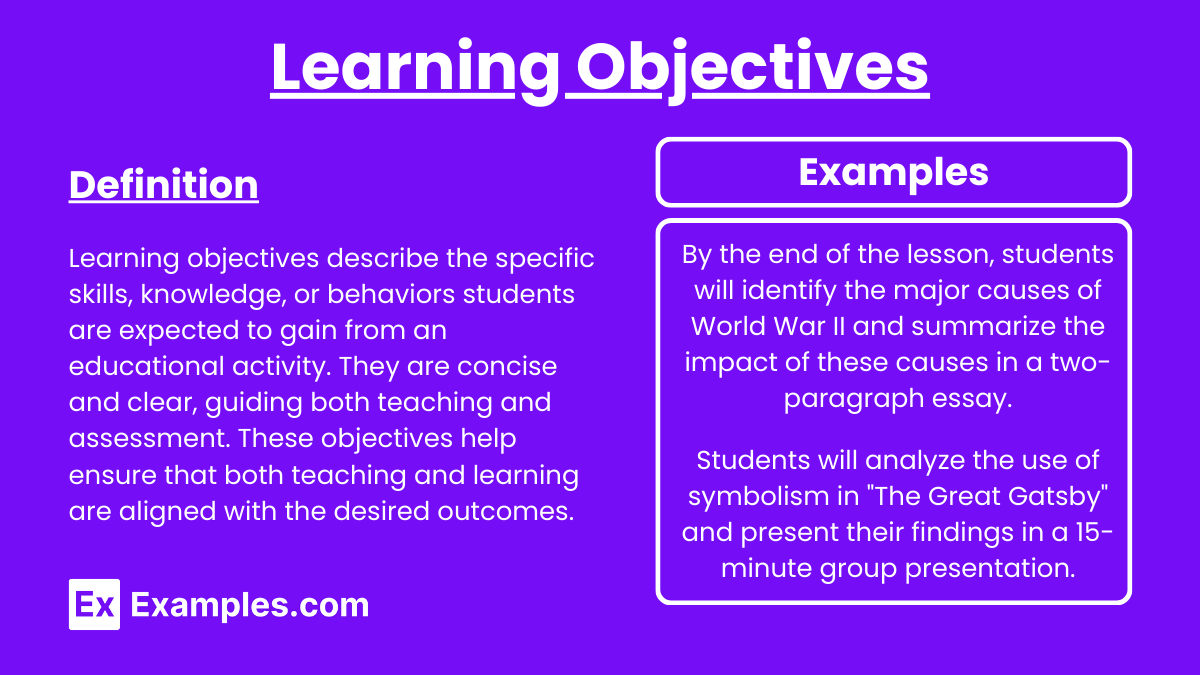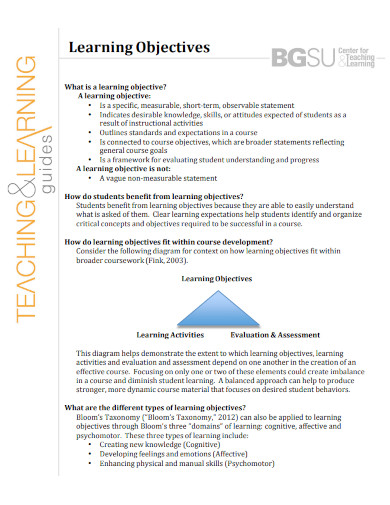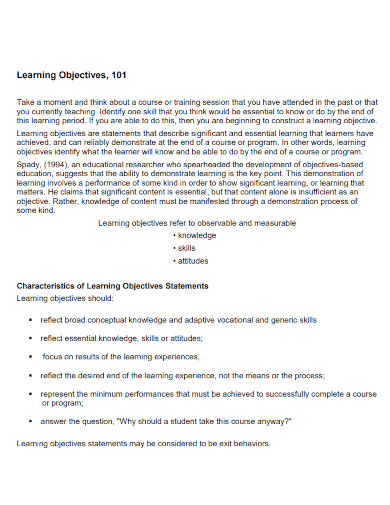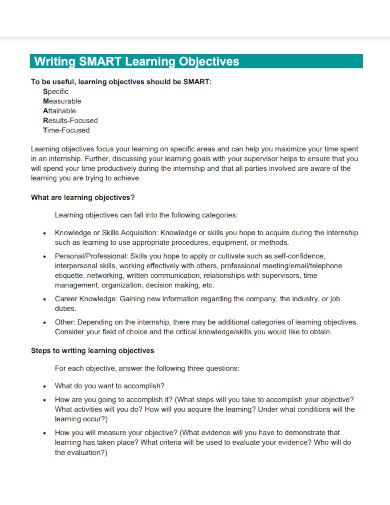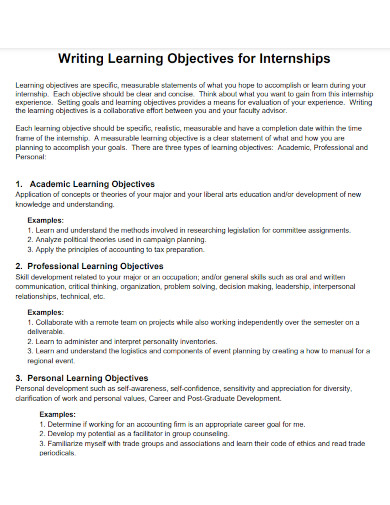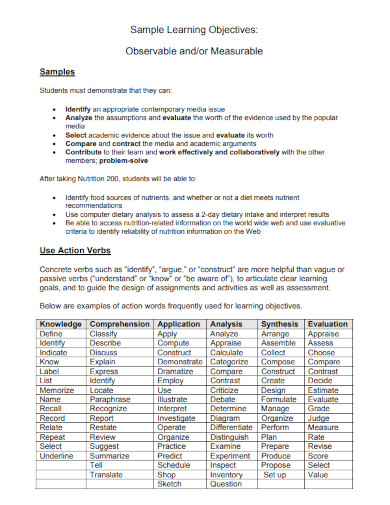40+ Learning Objectives Examples
There are plenty of ways to be better and learn more things in life. Learn to become efficient by setting learning objectives, learning goals, and long-term goals for yourself.
What Is a Learning Objective?
A learning objective is a target you set for yourself about particular abilities and information you wish to gain. The learning objective does not focus on the outcomes or results of a training program but instead places greater emphasis on the contexts, characteristics, elements, themes, and tones of the learning process.
Learning Objective Examples
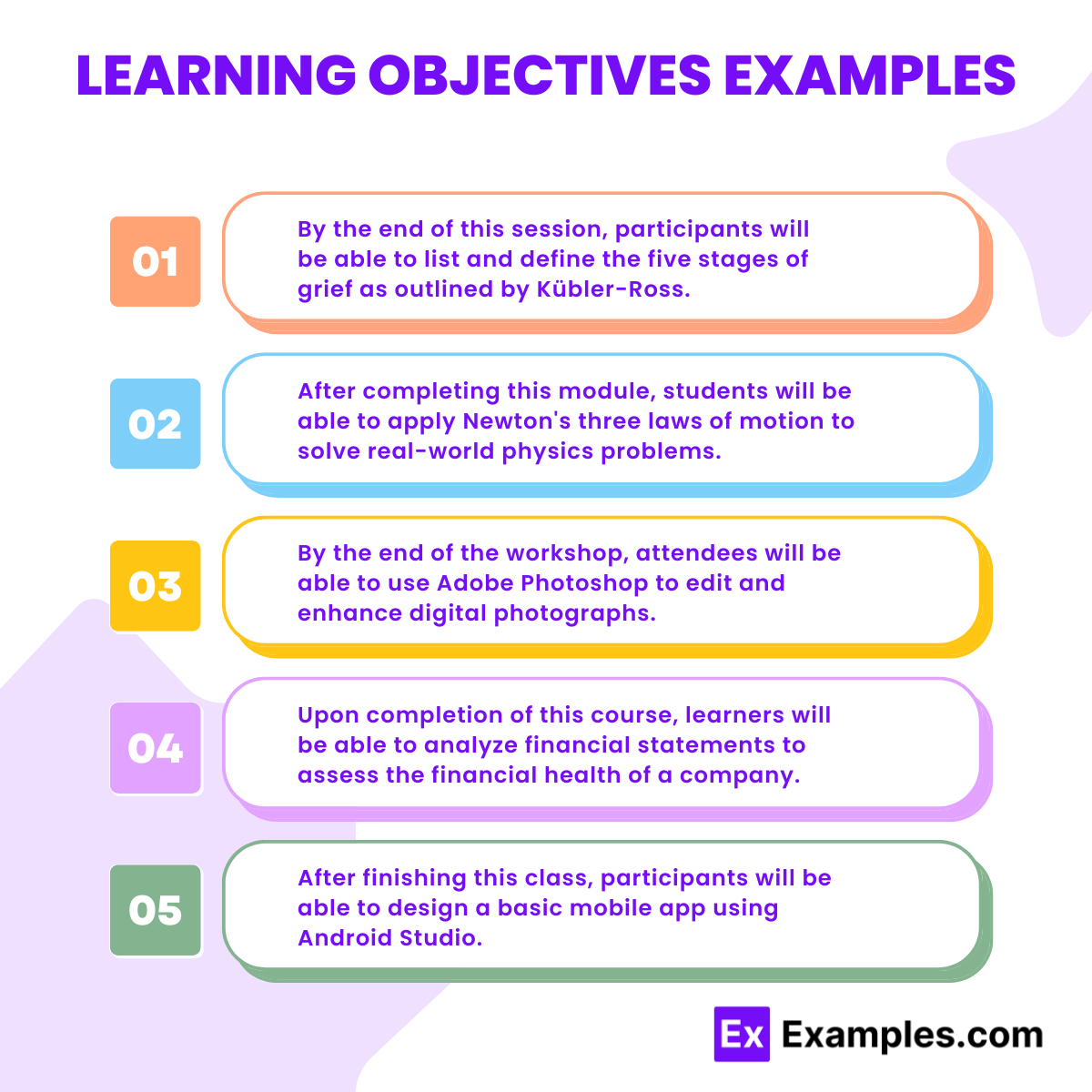
Academic Subjects
- Mathematics: Students will be able to solve quadratic equations using the quadratic formula and explain each step of their solution process.
- Science: Students will be able to describe the process of photosynthesis, including the role of light, carbon dioxide, and water in the formation of glucose and oxygen.
- History: Students will be able to compare and contrast the causes and effects of World War I and World War II.
Professional Training
- Customer Service Training: By the end of this course, participants will be able to handle three types of customer complaints using the company’s standard operating procedures.
- Software Development: Participants will be able to develop a basic web application using HTML, CSS, and JavaScript.
- Healthcare: Nurses will be able to demonstrate proper sterile dressing change techniques to prevent infection.
Personal Development
- Public Speaking: By the end of the workshop, participants will be able to construct and deliver a 10-minute presentation on an unfamiliar topic using persuasive communication techniques.
- Cooking Classes: Participants will be able to prepare three different types of pasta dishes using proper culinary techniques.
- Fitness Classes: Attendees will be able to perform a 30-minute yoga routine demonstrating correct posture and breathing techniques.
Learning Objectives Examples for Students
- Understand Basic Concepts: Grasp the fundamental principles of algebra by solving linear equations and graphing simple functions.
- Improve Reading Comprehension: Analyze themes and characters in assigned literature to enhance understanding and interpretation skills.
- Develop Scientific Methods: Conduct basic experiments to understand scientific inquiry and data analysis.
- Enhance Writing Skills: Write persuasive essays that argue a clear point of view with supporting evidence.
- Master Historical Events: Identify and explain the significance of major events in world history from ancient times to the present.
- Cultivate Artistic Techniques: Experiment with different art mediums to create original works and understand artistic expressions.
- Advance Physical Fitness: Achieve proficiency in various sports and understand the principles of health and physical education.
Learning Objectives Examples for Teachers
- Facilitate Inclusive Education: Design and implement lesson plans that accommodate diverse learning styles and needs.
- Enhance Classroom Management: Develop strategies to maintain a positive and productive classroom environment.
- Implement Technology: Integrate digital tools into teaching to enhance learning outcomes and student engagement.
- Assess Student Progress: Employ various assessment techniques to measure student learning and adjust instruction accordingly.
- Promote Critical Thinking: Encourage students to think critically and solve problems through innovative teaching methods.
- Support Emotional Development: Create a supportive atmosphere that fosters students’ emotional well-being and social skills.
- Engage with Parents: Communicate effectively with parents to promote a collaborative approach to education.
Learning Objectives Examples for Internship
- Develop Professional Skills: Gain hands-on experience in industry-specific practices and protocols.
- Enhance Communication Skills: Improve both verbal and written communication skills through regular interaction with team members and management.
- Learn Project Management: Assist in planning and executing projects, understanding timelines, and resource allocation.
- Understand Organizational Culture: Acclimate to the company’s culture and contribute to team meetings and corporate events.
- Build Networking Skills: Establish professional relationships within and outside the organization.
- Receive Mentorship: Benefit from the guidance and feedback of experienced professionals in the field.
- Contribute Meaningfully: Participate in meaningful work that contributes to the company’s goals and your professional growth.
Learning Objectives Examples in Lesson Plan
- Introduce New Concepts: Introduce students to the concept of photosynthesis and its role in the ecosystem.
- Stimulate Interest: Use interactive activities to engage students and stimulate interest in environmental science.
- Develop Skills: Teach students how to use microscopes to observe plant cells.
- Assess Understanding: Use quizzes and discussions to assess students’ understanding of the material.
- Encourage Application: Encourage students to apply their knowledge by starting a class garden project.
- Promote Teamwork: Facilitate group activities that foster collaboration and communication among students.
- Reflect on Learning: Have students reflect on their learning through a class blog or journal entries.
Learning Objectives Examples for College Students
- Achieve Academic Excellence: Master core concepts in your major to prepare for advanced courses.
- Develop Research Skills: Conduct independent research projects under faculty supervision.
- Participate in Internships: Apply classroom knowledge in real-world settings through internships.
- Enhance Leadership Skills: Take leadership roles in student organizations or community projects.
- Foster Global Awareness: Participate in study abroad programs to understand global issues and cultures.
- Build Professional Networks: Attend career fairs and networking events to connect with potential employers.
- Plan for Career: Develop a career plan with actionable steps towards your professional goals.
Writing Learning Objectives Examples
- Specify Learning Goals: Clearly define what students are expected to learn by the end of the course.
- Align with Standards: Ensure objectives are aligned with national or state educational standards.
- Be Measurable: Use action verbs that allow for measurable outcomes.
- Be Concise: Keep objectives clear and concise to ensure they are understandable.
- Target Different Levels: Include objectives that target various levels of learning, from basic knowledge to critical thinking.
- Incorporate Feedback: Design objectives that include opportunities for feedback to help students improve.
- Reflect on Relevance: Make sure objectives are relevant to the students’ academic and personal growth goals.
Purpose of Learning Objectives
Guiding Teaching and Learning
Learning objectives provide a clear focus for both instructors and students. They outline what students are expected to learn, which helps teachers plan their lessons and instructional activities effectively. For students, these objectives clarify the expectations and what they need to achieve by the end of a lesson or course.
Assessing Student Progress
Objectives make it easier to assess student progress and performance. By setting specific targets, educators can develop assessments that directly measure whether students have achieved the intended outcomes. This alignment helps ensure that assessments are relevant and meaningful.
Enhancing Student Motivation
When students understand the goals of their learning journey, they are more likely to be motivated. Learning objectives provide a roadmap, helping students see the purpose behind their activities and how these activities will help them achieve their educational and personal goals.
Ensuring Educational Alignment
Learning objectives help maintain alignment across the curriculum, instruction, and assessment. This alignment is crucial for ensuring that educational programs are coherent and that all components work together to support student learning effectively.
Effective Learning Objective
An effective learning subject is a clear, specific, and measurable statement that defines what students will know or be able to do as a result of a learning activity. It is designed to guide the instructional process and to assess students’ learning progress.
- Specific: It targets a precise skill or knowledge area.
- Measurable: It allows for assessment through observable outcomes.
- Attainable: It is achievable within the scope of the course or lesson.
- Relevant: It is aligned with course goals and useful for students.
- Time-bound: It includes a timeline for achievement.
Components of Learning Objectives
- Performance: Describes what the learners will be able to do, such as “Write”, “Identify”, “Solve”, “Create”.
- Condition: Specifies the conditions under which the performance should occur, like “Given a list of equations” or “Using a standard keyboard”.
- Criterion: States the standard by which the performance will be evaluated, for example, “With 95% accuracy” or “Without referring to notes”.
How to Create Personal Learning Objectives
Learning objectives can help a person succeed and achieve a sense of personal growth. To be efficient and effective, it is best if you use the SMART framework when setting your learning objectives. The SMART framework needs you to set Specific, Measurable, Achievable, Realistic, and Time-Sensitive goals or learning objectives.
1.) Make the Objective Specific
Begin by making the objective as specific as possible. This is because it is difficult to quantify a very broad learning objective, due to the wide space of interpretation. The opposite is also true, which means that the more specific the goal, the easier it is to quantify.
2.) Indicate the Vectors of Measurement
You will need to indicate the vectors of measurement to help ensure that your goal is quantifiable. This means that there needs to be a physical measurement that can act as the hallmark or a sign that the goal has been achieved.
3.) Set the Requirements for Achievement
The goal needs to be achievable, which means it has a specific set of observable requirements. Not only that, but the learning objective must also be reachable in the given period or deadline. If you need to know how to list out the requirements, you may opt to use outline or outline formats for this.
4.) Ensure the Learning objective is Realistic
The learning objective needs to be realistic. This means that the learning objective or goal should be catered to the specific person. This means that not all learning objectives can be applied to other people, as it may not be realistic for them to achieve in a particular timeline.
5.) Set Up a Deadline
The deadline is the outside source of motivation for the person to achieve their learning objective. This is because the deadline brings a sense of urgency into the mix, ensuring that the person will try their best to reach their learning objective before the deadline.
How to Write Learning Objectives?
Understand the Purpose
Learning objectives are clear, concise statements that define what learners will be able to do as a result of a learning event. They help guide the instructional process and assess learning outcomes, ensuring alignment between teaching activities and learning goals.
Follow the SMART Criteria
Learning objectives should be:
- Specific: Clearly define what the learner needs to learn or be able to do.
- Measurable: Articulate outcomes that can be measured in terms of knowledge, skills, and attitudes.
- Achievable: Ensure that the objectives can realistically be accomplished given the time and resources available.
- Relevant: Align the objectives with the overall course goals and the learners’ needs.
- Time-bound: Specify when the learners should meet the objectives.
Use an Action-Oriented Format
Begin each objective with an action verb that specifies the performance required. Avoid vague terms like “understand” or “learn” as they are difficult to measure. Instead, use Bloom’s Taxonomy to choose verbs that match the level of cognitive effort expected, such as:
- Remembering: Identify, list, describe
- Understanding: Explain, summarize, classify
- Applying: Demonstrate, use, execute
- Analyzing: Compare, contrast, categorize
- Evaluating: Assess, justify, critique
- Creating: Design, construct, develop
Example Objectives
- By the end of this lesson, students will be able to calculate the area and perimeter of rectangles and triangles.
- Students will critique three examples of persuasive writing, identifying the strengths and weaknesses of each.
- By the completion of this course, participants will be able to design an original research project that addresses a defined research question.
Review and Adjust
After drafting your objectives, review them to ensure they are clear and meet the SMART criteria. It may also be helpful to get feedback from colleagues or pilot them with a small group of students to ensure they are understandable and achievable. Adjust as necessary based on this feedback.
Skills Commonly Used in Creating Career Objectives
Writing and Communication Skills
Crafting effective career objectives requires strong writing skills to clearly and concisely convey your goals and aspirations. The ability to articulate your career vision and how a particular job fits into that vision is crucial. This involves selecting appropriate vocabulary, structuring sentences effectively, and tailoring the message to the intended audience, usually potential employers.
Strategic Thinking
Developing career objectives involves strategic thinking about where you want to be professionally in the short and long term. This skill helps you to align your career path with your overarching professional goals, considering your current skills, potential career opportunities, and personal aspirations.
Self-Assessment
Self-assessment skills are vital for identifying your strengths, weaknesses, interests, and values. Understanding these personal attributes allows you to create realistic and achievable career objectives that are aligned with your professional identity and personal growth goals.
Research Skills
To formulate informed career objectives, it’s important to research the industry, potential roles, and companies of interest. This research helps you understand the necessary qualifications, the industry’s direction, typical career paths, and organizational cultures, enabling you to tailor your objectives to fit real-world contexts.
Goal-Setting
Effective goal-setting is critical when defining career objectives. This involves understanding how to set SMART (Specific, Measurable, Achievable, Relevant, and Time-bound) goals. Proper goal-setting ensures that your career objectives are clear, achievable, and designed to propel you toward your desired career outcomes.
Learning Objectives in a Lesson Plan
Learning objectives are specific, measurable statements detailing what students are expected to learn or achieve by the end of a lesson. These objectives guide the teaching strategies and assessments used throughout the lesson.
Importance Learning Objectives in a Lesson Plan
- Focus: They provide a clear focus for both the teacher and students.
- Alignment: They help in aligning the lesson content with broader educational goals or standards.
- Assessment: They facilitate the creation of assessments that accurately measure students’ understanding.
- Motivation: They can motivate students by clearly defining the learning targets.
Characteristics of Effective Learning Objectives
- Specific: Clearly defines what students will learn.
- Measurable: Includes criteria that can be observed or measured.
- Achievable: Attainable for students within the lesson or class period.
- Relevant: Directly related to the course content and student needs.
- Time-bound: Achievable within the time allocated for the lesson.
Examples of Learning Objectives in a Lesson Plan
Here are a few examples of learning objectives for different subjects:
- Math: Students will be able to solve quadratic equations using the quadratic formula with 90% accuracy.
- History: Students will identify and describe the causes and effects of the American Revolution.
- Science: Students will demonstrate understanding of the water cycle by labeling all stages on a diagram.
- English: Students will write a five-paragraph essay that argues their position on a given topic, using proper grammar and punctuation.
What are Student Learning Objectives?
Student Learning Objectives (SLOs) are detailed, measurable goals used to assess the progress of students towards mastering specific skills or knowledge over a course or a year. SLOs are typically set by teachers at the beginning of the academic period and are used to track student progress, inform instructional strategies, and adjust teaching methods to meet the needs of students. These objectives are crucial in educational planning and are often aligned with standards and benchmarks to ensure they are objective and actionable.
Benefits of Learning Objectives
Clarity and Direction
Learning objectives provide clear, concise statements about what learners are expected to achieve by the end of a lesson or course. They help both instructors and students by outlining the specific knowledge, skills, and attitudes that should be developed. This clarity guides instructional planning and gives students a clear understanding of expectations, helping them focus their efforts more effectively.
Improved Teaching and Learning
With well-defined objectives, instructors can design their teaching strategies and materials to directly support targeted outcomes. This alignment enhances the effectiveness of teaching and can lead to more consistent and meaningful learning experiences for students. Learners benefit by understanding precisely what they need to learn, which can increase their motivation and engagement.
Assessment and Evaluation
Learning objectives are crucial for designing assessments that accurately measure student learning. They ensure that evaluations are aligned with the intended outcomes of the course, providing a direct link between what is taught and what is assessed. This alignment helps in fairly evaluating student performance and also in identifying areas where students may need additional support.
Progress Tracking and Feedback
Clear objectives allow both teachers and students to track progress throughout the course. Instructors can use them to provide targeted feedback, helping students understand where they are excelling and where they need improvement. This ongoing feedback loop can significantly enhance student learning and achievement.
Professional Development
For educators, the process of creating and refining learning theories is a valuable professional development tool. It encourages reflection on teaching practices and student outcomes, leading to continual improvement in instructional design and delivery. This iterative process helps teachers become more effective educators over time.
Steps to Implement Learning Objectives
- Define Clear Objectives: Begin by clearly defining what you want learners to achieve. Use action verbs that can be observed and measured, such as “describe,” “solve,” “analyze,” or “create.”
- Align Activities and Materials: Ensure that every learning activity, instructional material, and resource aligns with your objectives. This alignment keeps the course focused and maximizes educational efficiency.
- Communicate Expectations to Learners: Clearly communicate the objectives to your students at the beginning of the course or lesson. This helps set their expectations and focus their learning efforts.
- Use Objectives to Guide Assessments: Design assessments (quizzes, tests, projects, etc.) that directly measure the achievement of the learning objectives. This can include both formative assessments (to monitor learning progress) and summative assessments (to evaluate learning at the end of a course segment).
- Adjust Based on Feedback: Gather feedback from learners about their understanding and engagement. Use this data to adjust your instructional approaches and improve the learning experience.
- Review and Revise Objectives: Regularly review and update learning objectives based on curriculum changes, feedback, or shifts in educational standards.
What is Bloom’s Taxonomy?
Bloom’s Taxonomy is a framework developed by educational psychologist Benjamin Bloom in 1956, used to classify educational learning objectives into levels of complexity and specificity. The taxonomy aims to encourage higher forms of thinking in education, such as analyzing and evaluating concepts, rather than just remembering facts. It is widely used to guide the development of assessments, curriculum, and instructional methods.
The Three Domains of Bloom’s Taxonomy
- Cognitive: This domain involves knowledge and the development of intellectual skills. It includes six categories which were later revised to be more action-oriented: Remembering, Understanding, Applying, Analyzing, Evaluating, and Creating.
- Affective: This domain describes the way people react emotionally and their ability to feel another living thing’s pain or joy. It ranges from the simplest awareness to the more complex forms of internalization or commitment.
- Psychomotor: This domain focuses on manual or physical skills. It includes actions which are measured in terms of precision, control, efficiency, and execution.
The Levels of the Cognitive Domain
- Remembering: Recognizing or recalling facts, terms, basic concepts, or answers.
- Understanding: Demonstrating understanding of facts and ideas by organizing, comparing, translating, interpreting, giving descriptions, and stating main ideas.
- Applying: Using new knowledge to solve problems in new situations by applying acquired knowledge, facts, techniques, and rules.
- Analyzing: Examining and breaking information into parts by identifying motives or causes; making inferences and finding evidence to support generalizations.
- Evaluating: Presenting and defending opinions by making judgments about information, validity of ideas, or quality of work based on a set of criteria.
- Creating: Combining elements to form a coherent or functional whole; reorganizing elements to form a new pattern or structure through generating, planning, or producing.
Relationship between Bloom’s Taxonomy and Learning Objectives
Bloom’s Taxonomy directly influences the formulation of learning objectives by providing a structured framework to craft clear, measurable, and achievable goals at different levels of learning complexity. It helps educators design objectives that not only cover basic knowledge acquisition (remembering and understanding) but also encourage higher-order thinking skills such as applying, analyzing, evaluating, and creating. By using this taxonomy, educators can ensure that learning objectives are diversified across cognitive, affective, and psychomotor domains, thereby catering to comprehensive skill development and deeper learning experiences for students. This methodical approach allows for targeted teaching strategies and assessments that align with desired educational outcomes, making learning both effective and efficient.
1. Learning Objectives Examples
2. Basic Guide to Learning Objectives
3. Writing Smart Learning Objectives
4. Writing Learning Objectives for Internships
5. Sample Learning Objectives
Why are learning objectives important?
Learning objectives guide instruction, provide clear expectations, and help measure student progress, ensuring effective teaching and learning.
How do you write effective learning objectives?
Write clear, specific, measurable, achievable, relevant, and time-bound objectives using action verbs that define student outcomes.
What are some examples of learning objectives?
Examples include: “Students will be able to analyze historical events” or “Students will demonstrate proficiency in algebraic equations.”
How do learning objectives differ from learning goals?
Learning objectives are specific, measurable outcomes, while learning goals are broader, general aspirations for student learning.
Can learning objectives be changed during a course?
Yes, learning objectives can be adjusted based on student needs, progress, and feedback to ensure effective learning.
How do you assess learning objectives?
Assess learning objectives through quizzes, exams, projects, presentations, and other measurable assessments aligned with the objectives.
What is the role of learning objectives in curriculum design?
Learning objectives shape curriculum design by defining the content, activities, and assessments necessary to achieve desired student outcomes.
How do learning objectives benefit students?
Learning objectives provide students with clear expectations, focus their learning efforts, and help track their progress and achievements.
What are Bloom’s Taxonomy and its relevance to learning objectives?
Bloom’s Taxonomy categorizes learning objectives into cognitive levels, guiding educators in creating objectives that foster higher-order thinking skills.



